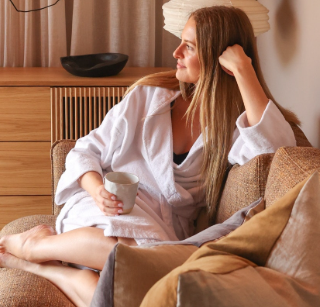A restful night’s sleep starts long before your head touches the pillow. The environment you create around yourself can profoundly influence how quickly you fall asleep and the quality of rest you achieve. Preparing for sleep in a calm, soothing setting helps your body and mind transition naturally from the busy energy of the day to a state of relaxation. By paying attention to simple habits and environmental cues, you can cultivate a nightly ritual that supports deep, rejuvenating sleep.
The first step to creating a calming sleep environment is to consider the lighting in your bedroom. Bright, harsh lights can signal to your brain that it is still daytime, making it harder to unwind. To prepare for sleep, opt for soft, warm lighting that mimics the natural progression toward evening. Bedside lamps, dimmable lights, or even candles (used safely) can help set a tranquil mood. If possible, allow natural light to fill your space during the day, and gently transition to softer lighting as night approaches. This rhythmic change informs your body that it is time to slow down and prepare for rest.
Temperature also plays a crucial role in sleep readiness. Most people find it easier to fall asleep in a slightly cooler room, as the body naturally drops its temperature in preparation for sleep. Maintaining a comfortable environment around 65 to 70 degrees Fahrenheit supports this natural process. Heavy blankets or too warm a room can cause restlessness, while a room that is too cold may make it difficult to relax. Investing in breathable bedding and adjusting layers as needed can create a balance that feels just right for your body.
Sound is another important factor that can either disrupt or enhance your sleep. While complete silence can be soothing for some, others may find subtle background sounds comforting. Gentle white noise, soft music, or the sound of nature can mask disruptive noises and create a steady, calming backdrop. Avoid alarms or notifications that may interrupt the transition into sleep. If external noises are unavoidable, consider earplugs or a white noise machine to maintain a serene auditory environment.
Decluttering your bedroom can also contribute significantly to a sense of calm. A space that feels organized and free of distractions helps the mind let go of daily worries. Taking a few moments each evening to tidy up, put away items that are out of place, and create a visually serene environment encourages a more peaceful mindset. Your bedroom should be a sanctuary that invites relaxation rather than a space that reminds you of unfinished tasks or stress.
A mindful pre-sleep routine further enhances the calming effects of your environment. Engaging in gentle activities such as reading a favorite book, journaling thoughts and reflections, or practicing light stretches can signal to your body that the day is winding down. These moments of intentional calm help lower stress hormones and prepare the mind for restorative sleep. Avoiding stimulating activities such as intense exercise, work-related tasks, or scrolling on electronic devices can prevent your brain from staying in a state of heightened alertness.
Technology use is especially important to manage when preparing for sleep. The blue light emitted by screens can suppress melatonin production, the hormone responsible for regulating sleep-wake cycles. Limiting screen time at least an hour before bed allows your body’s natural rhythms to take over. Instead, consider reading, listening to calming audio, or engaging in a quiet hobby. If screens are necessary, using a blue light filter or night mode can reduce the impact on your sleep cycle.
Scent can subtly influence the atmosphere of your bedroom and promote relaxation. Aromatherapy using essential oils like lavender, chamomile, or sandalwood can create a soothing sensory experience. Diffusing a mild fragrance in your room or using scented linen sprays can help your mind associate the environment with calmness and rest. Just ensure that the scents are not overpowering and are consistent with your personal preferences for comfort.
Paying attention to your sleep position and bedding can further enhance your comfort. A supportive mattress and pillow suited to your sleeping style help prevent discomfort or restlessness. Experimenting with positioning, whether on your back, side, or stomach, allows you to find the most natural and relaxing posture. Comfortable bedding and pajamas that suit the room’s temperature can make a notable difference in how quickly you drift into a deep sleep.
Hydration and diet in the evening also contribute to a calm sleep environment. Avoiding heavy meals, caffeine, or excessive sugar close to bedtime reduces the likelihood of digestive discomfort or alertness that can interfere with falling asleep. A light snack or a cup of herbal tea can have a soothing effect, preparing your body for rest without overloading the digestive system. Drinking adequate water throughout the day and limiting intake just before bed can prevent nighttime disruptions while still keeping you comfortably hydrated.
Mental preparation is just as important as physical comfort. A few moments of meditation, deep breathing, or visualization can calm the mind and create a sense of closure for the day. Reflecting on what went well during the day or writing down concerns can prevent them from lingering in your thoughts as you try to sleep. Cultivating gratitude or setting gentle intentions for the next day can also contribute to a positive mental state conducive to restful sleep.
Consistency in your sleep schedule reinforces your body’s natural rhythm. Going to bed and waking up at similar times every day, even on weekends, strengthens the signals your body receives about when to prepare for sleep. Over time, this predictability allows your body to naturally adjust, making it easier to fall asleep quickly and maintain deep, uninterrupted rest. A calm environment combined with a consistent schedule creates the ideal foundation for restorative sleep night after night.
In essence, preparing for sleep in a calm environment involves harmonizing physical, sensory, and mental elements. By thoughtfully managing light, temperature, sound, clutter, technology, and personal habits, you create a space that encourages the body to relax and the mind to unwind. Over time, these small yet intentional adjustments can transform your nightly routine into a comforting, restorative ritual that supports both physical well-being and emotional balance.
A calm sleep environment is not merely about aesthetics or comfort—it is about creating conditions that allow your body and mind to synchronize with their natural rhythms. By approaching your bedtime with mindfulness, you can cultivate a sanctuary that nurtures restful sleep. Each night becomes an opportunity to step away from the demands of the day and enter a state of serenity, setting the stage for renewed energy and clarity upon waking.
Taking the time to prepare your environment thoughtfully is a gift to yourself. Sleep is not a passive state but an active process influenced by the space around you. With intention and attention, you can transform your bedroom into a haven of calm, where the body can restore itself and the mind can find peace. Embracing these practices allows for not just a better night’s sleep but a more balanced, energized, and resilient day ahead.






